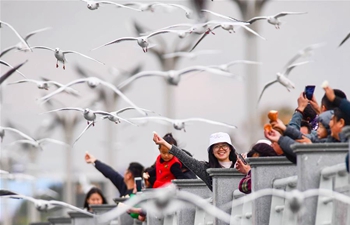NANNING, Jan. 2 (Xinhua) -- After a harrowing break-up with her boyfriend in 2017, Fan Lihua decided not to wallow in sorrow, but instead created three wedding dresses for herself.
Following Zhuang brocade traditions, the 24-year-old designer dotted her wedding gowns with symbols of love and marriage, like flowers of longevity and mandarin ducks. The ornate dresses have not helped win back Fan's loved one, but instead scooped a gold award in an arts and crafts competition for ingenious use of ancient textiles.
Now recalling her "unfailing romance" with Zhuang brocade, Fan, from south China's Guangxi Zhuang Autonomous Region, says she hopes to make more people fall in love with this ancient art form.
"My goal is to take Zhuang brocade out of Guangxi, and beyond China, to make it known by more people," Fan said.
Zhuang brocade has adorned quilts and straps of Zhuang people, the most populous ethnic minority in China, for over 2,000 years. Now a new generation of designers are trying to bring these designs on to wedding dresses and daily clothing.
Though not an ethnic Zhuang, Fan has developed a passion for the ethnic craft since childhood. When participating a college exhibition as an apparel design major, Fan came up with garments imbued with Zhuang brocade elements, which got the attention of Tan Xiangguang, a renowned Zhuang brocade artist.
"Though Fan did not display a profound understanding of Zhuang brocade back then, she really inspired me by bringing the brocade onto daily clothing," said Tan, a retired professor who runs a program to promote the Zhuang brocade culture.
With Tan's support, Fan opened a studio with a second-hand sewing machine soon after her college graduation in 2016. Her business had a rough start, cooperating with some less-known ethnic-style brands, but Fan still considered herself lucky compared with previous generations of artisans.
"In the 1980s, Professor Tan had to work in a garment factory to make ends meet, but now I can devote myself fully to the art that I love. Financial burdens are not really a big problem," she said.
Fan is now focusing on waistcoats, which she said may be a new frontier for Zhuang brocade.
"Most garments can only use few Zhuang brocade patterns as decoration, because of its hardened texture, but this is exactly what a waistcoat needs," Fan said. "The repetitive rectangle patterns of Zhuang brocade also makes a waistcoat look more tasteful."
Her other designs also raised interest both online and brick-and-mortar shops, including handbags, document pouches and iPad shells all given a lively ethnic flavor by Zhuang brocade patterns.
"We are still doing 'quantitive accumulation' for Zhuang brocade, which lacks a good variety of products to become a brand," Fan said.
China in 2006 enlisted Zhuang brocade as the country's first group of intangible cultural heritage in a bid to better protect the art. Like many other traditional arts and crafts, its generational passage is facing a shrinking pool of successors.
"Youngsters with fine arts and designing backgrounds are increasingly needed by the traditional cultures as the latter struggles to find modern expressions," said Liang Liang, who heads the culture and creativity products department of the Anthropology Museum of Guangxi.
But with scarcity comes opportunities. Liang said cultural and creative products had great potential, especially in Guangxi, a region heavily inhabited by ethnic minorities.
Fan is also optimistic about her life and career now deeply intertwined with the Zhuang brocade.
"The day I debuted my Zhuang brocade wedding dresses, I was surrounded by my family, friends and classmates who came to congratulate me. It was just like my sister's wedding. I wish that I will be dressing in them when I marry the one I love."

















